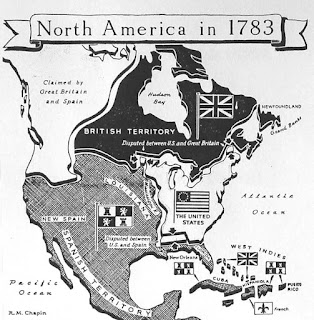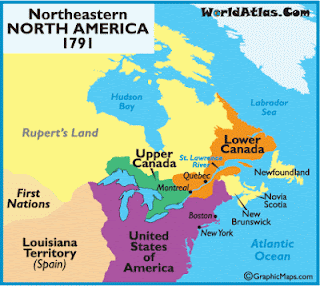The following summary that I've written for you complements the project that you are handing in tomorrow and/or Tuesday. There are links and maps provided; feel free to use them or to find your own. This is project ends the section on the first fifty years after the change of empire.
This week we are beginning the next period of British rule - after 1815 - in which Quebec underwent tremendous social change.
First 50 years of British rule: 1763-1815:
British control of New France officially began in 1763, with the signing of the Treaty of Paris. New British laws were introduced to the colony with the Royal Proclamation and the boundaries of Quebec were reduced considerably (see below, map 1). The first British governor of "Quebec," James Murray, was faced with a difficult situation; he was expected to implement laws and policies that would ultimately assimilate an overwhelmingly French-canadien society. 99% of the population was French-Catholic; 75% were rural and were farmers. Very few English subjects arrived in Quebec; they numbered about 500 in the mid-1760's. The English merchants in Quebec were interested in controlling the economy, as well as the government, passing laws from which they would benefit. Governor Murray, however, was sympathetic to canadiens farmers and seigneurs, even to the Catholic church; he found himself in direct opposition to the English merchants, owing to his conciliatory attitude toward the French majority.
In 1775, the American War of Independence began in the Thirteen Colonies. It had a major impact on Quebec's territory (before and after American independence), as well as on its society. Prior to the revolution, the British government expanded Quebec's boundaries (Quebec Act, 1774) to include the Ohio Valley (see map 2). This move by the British further enraged the governments and citizens of the Thirteen Colonies. During the American revolution, not everyone fought for independence; there were many who wanted continued ties with the British. Many of them suffered terrible things in America because of their support for the British King. These people came to be known as the "Loyalists." Thousands of them left the American colonies seeking safety; approximately 6000 arrived in Quebec in the late 1770's, early-1780's because Quebec was under British rule. Lastly, in 1783, Quebec lost the territory south of the Great Lakes to the newly created USA.
This week we are beginning the next period of British rule - after 1815 - in which Quebec underwent tremendous social change.
First 50 years of British rule: 1763-1815:
British control of New France officially began in 1763, with the signing of the Treaty of Paris. New British laws were introduced to the colony with the Royal Proclamation and the boundaries of Quebec were reduced considerably (see below, map 1). The first British governor of "Quebec," James Murray, was faced with a difficult situation; he was expected to implement laws and policies that would ultimately assimilate an overwhelmingly French-canadien society. 99% of the population was French-Catholic; 75% were rural and were farmers. Very few English subjects arrived in Quebec; they numbered about 500 in the mid-1760's. The English merchants in Quebec were interested in controlling the economy, as well as the government, passing laws from which they would benefit. Governor Murray, however, was sympathetic to canadiens farmers and seigneurs, even to the Catholic church; he found himself in direct opposition to the English merchants, owing to his conciliatory attitude toward the French majority.
In 1775, the American War of Independence began in the Thirteen Colonies. It had a major impact on Quebec's territory (before and after American independence), as well as on its society. Prior to the revolution, the British government expanded Quebec's boundaries (Quebec Act, 1774) to include the Ohio Valley (see map 2). This move by the British further enraged the governments and citizens of the Thirteen Colonies. During the American revolution, not everyone fought for independence; there were many who wanted continued ties with the British. Many of them suffered terrible things in America because of their support for the British King. These people came to be known as the "Loyalists." Thousands of them left the American colonies seeking safety; approximately 6000 arrived in Quebec in the late 1770's, early-1780's because Quebec was under British rule. Lastly, in 1783, Quebec lost the territory south of the Great Lakes to the newly created USA.
The Loyalist arrival had a tremendous social effect on Quebec; it was the true beginning of dualism in Quebec. By 1784, the English-speaking population made up 15% of Quebec's population. The Loyalists who arrived in Quebec expected to find British institutions: laws, Protestant churches, out-right ownership of land, and the right to vote. Instead they found French-language institutions which were unfamiliar - and no representative body in government. The British solved the problem by settling the Loyalists in the western part of Quebec (the Great Lakes region) and then dividing Quebec into two separate colonies, Lower and Upper Canada (see map below). This was enacted in the Constitutional Act, of 1791. In 1791, Upper Canada numbered 12 000; by 1800, there were 50 000 people.





Hey look I'm actually using your blog... Isn't that amazing? -jonah
ReplyDeleteIt is! You're the first to have written on here this year.
DeleteHow 'bout that cartoon...? :)